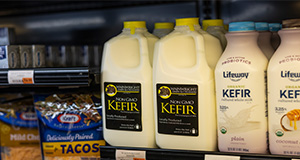Abstract
Kefir is a fermented dairy beverage made from milk and kefir grains containing yeast and bacteria. This publication describes how kefir is made and its potential health effects for consumers. Written by Julia R. Skinner, and published by the UF/IFAS Food Science and Human Nutrition Department, July 2024.
References
Azizi, N. F., Kumar, M. R., Yeap, S. K., Abdullah, J. O., Khalid, M., Omar, A. R., et al. (2021). Kefir and its biological activities. Foods, 10(6), 1210. https://doi.org/10.3390/foods10061210
Baker, S. (2023). Kefir vs. yogurt: Similarities and differences. The Dairy Alliance. https://thedairyalliance.com/blog/kefir-vs-yogurt-whats-the-difference/#:~:text=Though%20both%20are%20made%20with,it%20looks%20like%20a%20grain
Bellikci-Koyu, E., Sarer-Yurekli, B. P., Akyon, Y., Aydin-Kose, F., Karagozlu, C., Ozgen, A. G., et al. (2019). Effects of regular kefir consumption on gut microbiota in patients with metabolic syndrome: A parallel-group, randomized, controlled study. Nutrients, 11(9). https://doi.org/10.3390/nu11092089
Cannavale, C. N., Mysonhimer, A. R., Bailey, M. A., Cohen, N. J., Holscher, H. D., & Khan, N. A. (2023). Consumption of a fermented dairy beverage improves hippocampal-dependent relational memory in a randomized, controlled cross-over trial. Nutr. Neurosci., 26(3), 265–274. https://doi.org/10.1080/1028415X.2022.2046963
Dias, P. A., da Silva, D. T., Tejada, T. S., Garcia Moraes Leal, M. C., da Conceição, R. d. C. d. S., & Timm, C. D. (2012). Sobrevivência de micro-organismos patogênicos em kefir (Survival of pathogenic microorganisms in kefir). Rev. Inst. Adolfo Lutz., 71(1), 182–186. https://doi.org/10.53393/rial.2012.71.32410
Dong-Hyeon, K., Dana, J., Song, K., & Kun-Ho, S. (2018). Comparison of traditional and backslopping methods for kefir fermentation based on physicochemical and microbiological characteristics. LWT, 97, 503–507. https://doi.org/10.1016/j.lwt.2018.07.023
Farag, M. A., Jomaa, S. A., Abd El-Wahed, A., & El-Seedi, H. R. (2020). The many faces of kefir fermented dairy products: Quality characteristics, flavour chemistry, nutritional value, health benefits, and safety. Nutrients, 12(2), 346. https://doi.org/10.3390/nu12020346
Food and Drug Administration Department of Health and Human Services. (2024). Title 21—Food and Drugs Chapter I. Subchapter B - Food For Human Consumption. Part 131 – Milk and Cream. Subpart B - Requirements for Specific Standardized Milk and Cream. Sec. 131.112 Cultured milk. https://www.accessdata.fda.gov/scripts/cdrh/cfdocs/cfcfr/CFRSearch.cfm?fr=131.112
Hertzler, S. R., & Clancy, S. M. (2003). Kefir improves lactose digestion and tolerance in adults with lactose maldigestion. J. Am. Diet Assoc., 103(5), 582–587. https://doi.org/10.1053/jada.2003.50111
Hill, C., Guarner, F., Reid, G., Gibson, G. R., Merenstein, D. J., Pot, B., et al. (2014). Expert consensus document. The International Scientific Association for Probiotics and Prebiotics consensus statement on the scope and appropriate use of the term probiotic. Nat. Rev. Gastroenterol. Hepatol., 11(8), 506–514. https://doi.org/10.1038/nrgastro.2014.66
Kalamaki, M. S., & Angelidis, A. S. (2023). Growth and survival of Listeria monocytogenes during the manufacture and storage of artisanal kefir. Food Science and Technology International, 29(8), 789–798. https://doi.org/10.1177/10820132221117462
Kim, Y., Shim, Y. S., & Lee, K. G. (2022). Determination of alcohols in various fermented food matrices using gas chromatography-flame ionization detector for Halal certification. Food Science and Biotechnology, 31(13), 1639–1646. https://doi.org/10.1007/s10068-022-01156-2
Nagaoka, S. (2019). Yogurt production. In Lactic Acid Bacteria: Methods and Protocols (pp. 45–54). https://doi.org/10.1007/978-1-4939-8907-2_5
Nielsen, B., Gürakan, G. C., & Ünlü, G. (2014). Kefir: a multifaceted fermented dairy product. Probiotics Antimicrob. Proteins, 6, 123–135. https://doi.org/10.1007/s12602-014-9168-0
Rahmatullah, S., Irwansyah, F. S., Alifia, W. Q., & Putri, T. R. (2023). Analysis of alcohol content based on fermentation temperature of milk kefir. AIP Conference Proceedings, 2646(1), 7. AIP Publishing. https://doi.org/10.1063/5.0117196
Rosa, D. D., Dias, M. M., Grześkowiak, Ł. M., Reis, S. A., Conceição, L. L., & Maria do Carmo, G. P. (2017). Milk kefir: Nutritional, microbiological and health benefits. Nutr. Res. Rev., 30(1), 82–96. https://doi.org/10.1017/S0954422416000275
Salari, A., Ghodrat, S., Gheflati, A., Jarahi, L., Hashemi, M., & Afshari, A. (2021). Effect of kefir beverage consumption on glycemic control: A systematic review and meta-analysis of randomized controlled clinical trials. Complement Ther. Clin. Pract., 44, 101443. https://doi.org/10.1016/j.ctcp.2021.101443
U.S. Department of Agriculture. (2023). FoodData Central Agricultural Research Service. https://fdc.nal.usda.gov
U.S. Department of Health and Human Services. (2023). People at risk of food poisoning. https://www.foodsafety.gov/people-at-risk
Yahyapoor, F., Haghighat, N., Sohrabi, Z., Asbaghi, O., Bagherniya, M., Jamialahmadi, T., et al. (2023). Effects of kefir consumption on cardiometabolic risk factors: A systematic review and meta-analysis of randomized controlled trials. Curr. Drug Targets, 24(7), 599–612. https://doi.org/10.2174/1389450124666230427095742
Zhang, X., Luo, Q., Guan, X., Tang, Y., Chen, X., Deng, J., et al. (2023). Effects of fermented dairy products on inflammatory biomarkers: A meta-analysis. Nutr. Metab. Cardiovasc. Dis., 33(3), 471–482. https://doi.org/10.1016/j.numecd.2022.12.014

This work is licensed under a Creative Commons Attribution-NonCommercial-NoDerivatives 4.0 International License.
Copyright (c) 2024 UF/IFAS

